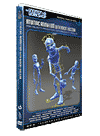
Robert Kuczera's Maya Character Animation Tutorial DVD

Robert Kuczera's Maya Character Animation Tutorial DVD
| Hi folks!
Robert Kuczera studied animation at the Film Academy Ludwigsburg, Germany and now lives in Munich. His website shows amazingly realistic looking 3D humans. That's why I was suprised to hear that Robert has created a tutorial DVD on character animation, released by the Gnomon School of Animation in May, 2008. This page tells you if it's worthwhile buying the DVD. I bought it online via direct download. |
Liebe Leute, Robert Kuczera ist ein an der Filmakademie Ludwigsburg ausgebildeter, heute in München lebender Maya-Spezialist. Seine Webseite zeigte schon vor Jahren hyperrealistische 3D-Köpfe. Dass Robert jetzt für die Gnomon School of Animation eine Lehr-DVD für Charakteranimation herstellte, hat mich verwundert. Ich hätte eher mit einer DVD über Texturierung und Modellierung gerechnet. Auf dieser Seite könnt Ihr lesen, ob es sich lohnt, sich die DVD zu kaufen. Vorweg: die Portokosten von Kalifornien nach Europa sind hoch. Es gibt alternativ die Möglichkeit des bezahlten Downloads. |
|
The tutorial takes about 2 hours to show the viewer how to animate a 3D character according to a live video sequence of 5 seconds. Robert used a free rig which he downloaded from the internet. To me it doesn't look very inviting, but Robert calls it perfect for training. The video shows himself playing with a little ball and finally throwing it against a wall. |
Das Tutorial erzählt in etwa 2 Stunden, wie man einen Character nach einer Videovorlage animiert. Die 3D-Figur hat Robert aus dem Web heruntergeladen. Sie ist nicht besonders attraktiv, aber seiner Meinung nach perfekt zum Üben. Den 5 Sekunden kurzen Videofilm hat er von festem Stativ aus selbst gedreht; er ist darauf selbst zu sehen, wie er einen Ball lässig zweimal mit der Hand hochwirft und dann gegen eine Wand schmettert. |
| Robert speaks good English, most times in a low, sometimes whispery voice. He starts the journey with slight modifications of the Maya working environment. He creates one or two MEL-scripts to ease the setting of keyframes for this specific rig. He deletes layers and sets up and freezes the camera by locking all its attributes. Then he calls up the video and searches for key poses. He finds a handful of poses and transfers them to the 3D character. A very lengthy, highly controlled procedure with hundreds of joint rotations. | Robert spricht gutes Englisch, oft sehr leise. Zunächst baut er geringfügig die Arbeitsumgebung in Maya um, erzeugt ein, zwei MEL-Scripts, um leichter Keyframes setzen zu können, löscht Layer des Original-Characters, richtet die Kamera ein, friert sie ein, indem er alle ihre Attribute sperrt. Dann ruft er das Video auf und sucht sich eine Handvoll Schlüssel-Stellungen (Key Poses) heraus. Dann beginnt die Arbeit. In einem aufwändigen Prozess dreht seine 3D-Figur in diese Posen: |
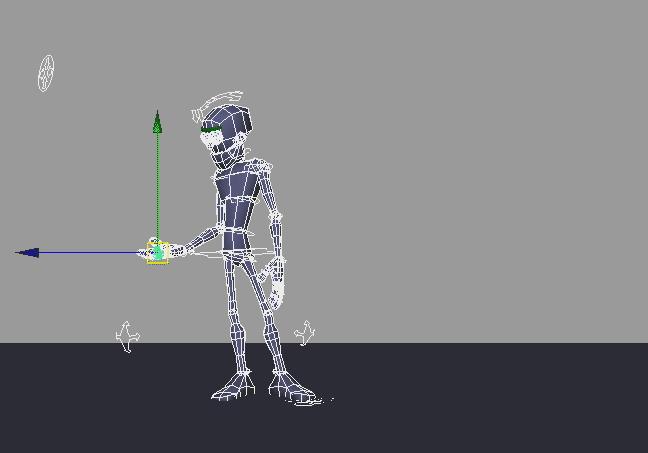
|
Robert stresses the point that the key poses are crucial to the animation to follow. He puts a lot of effort into making them look convincing, giving the character weight etc. But to this point there's no animation in the scene. He keys the poses in the timeline using double keyframes. This freezes them at their appropriate time slots. When scrubbing through the timeline there's no animation, just a harsh change from pose to pose. No Maya poses (a special feature of nonlinear animation) are being used, just straight forward keyframes. |
Er verwendet viel Zeit darauf, die Schlüsselstellungen fein an das Video anzupassen, ihnen insbesondere "Gewicht" zu geben, aber er animiert sie noch nicht, sondern schreibt die Positionen in der Zeitleiste mit zwei identischen Keyframes fest. Die Ausdrucksstärke sieht man auch in der nächsten Abbildung - die Pose vor dem Wurf gegen die Wand. Die Schlüsselstellungen speichert Robert Kuczera nicht als Maya Poses ab, sondern er setzt seine "doppelten Keyframes" bereits an den richtigen Stellen der Zeitleiste. Beim Durchfahren der Animation ist dann keine Bewegung, sondern ein plötzlicher Wechsel von einer Stellung in die nächste zu sehen. |
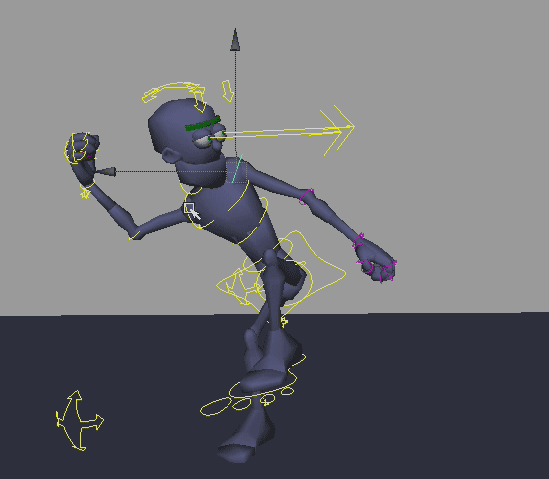
|
Robert Kuczera uses the rig in FK mode, i.e. he rotates and moves one jount after the other instead of picking the character's hand and the rest follows (IK). He like this feeling of puppet animation and says that inverse kinematics take too much control out of his hands. In the next pass Robert deletes the double keyframes. With only one keyframe per pose Maya now starts to interpolate from keyframe to key. With "spline" as the default interpolation setting the movements are extremely soft and frequently over-shooting. The whole behaviour of the character looks unnatural. This kicks of the major part of the tutorial, about one and a half hours long. Robert sets keyframes, reposes the rig, cuts, scales, moves keyframes, reposes the rig. Thousands of times, never leaving the standard view. I found it unique that he massively uses the camera window, rarely switching to the perspective window. He never really messes up the skeleton by rotating the joints in the wrong direction. He does all keyframing in the time line. He does this with such detail that after a while the 3D character handles the ball just as naturally as the original on video. Only when he encounters larger problems between certain keyframes, Robert calls up the Graph Editor to fix them within seconds. Sometimes so fast that the untrained viewer won't even know what he did. The Graph Editor is about the only extra window he uses. He uses it massivly at the very end to clean up things. Doing this he mainly adjusts tangents. He rarely deletes keyframes even when they look odd in the Graph Editor. Robert says the minor changes represented here are of high relevance. |
Alle Körperstellungen erreicht er mit Hilfe von FK, also der Technik, bei der man ein Gelenk nach dem anderen bewegt und dreht, statt mit Hilfe von Inverser Kinematik (IK), wo man z.B. die Hand anfasst, und der Rest des Körpers folgt. Robert legt Wert auf dieses Puppentrick-Gefühl. IK nimmt ihm zu viel Kontrolle aus der Hand. Im nächsten Durchgang löscht er nun die doppelten Keyframes. Damit geht eine Körperhaltung in die nächste über. Diese Übergänge lässt er weich ablaufen, nämlich mit Spline-Animationskurven. Obwohl die Figur sich jetzt bewegt, bewegt sie sich so unnatürlich, viel zu weich, zu ausdrucksschwach. Robert verwendet nun den größten Teil des Tutorials - etwa eineinhalb Stunden - darauf, diese Übergänge zu gestalten und blendet dazu laufend das Live Video ein. Er setzt laufend Keyframes, löscht andere, skaliert und verschiebt Keyframes. Dazu verlässt er nie die Zeitleiste am unteren Rand des Maya-Fensters. Überhaupt arbeitet er fast ausschließlich in der einen starren Kameraansicht, und er dreht seine Figur offenbar so gekonnt mit Tausenden kleiner Nachbesserungen, dass sie nicht nur ähnlich ausdrucksstark mit dem Ball umgeht, wie die Figur in dem Video, sondern sich auch nur selten in sich unnatürlich verbiegt. Dann wechselt er ins Perspektivfenster, um das zu richten. Selten bemüht Robert Kuczera den Graph Editor, um krasse Fehlbewegungen zu korrigieren. Andere Fenster ruft er nie auf. Erst ganz am Schluss, nach x Durchgängen, bei denen auch die Augen und Finger animiert werden und die Figur ein wenig Dehnung und Stauchung bekommt, um einen Comic-Effekt zu erreichen, erst ganz am Schluss korrigiert er alle Animationsverläufe im Graph Editor. Er löscht dabei selten Keyframes, sondern verändert nur ihre Tangenten: |
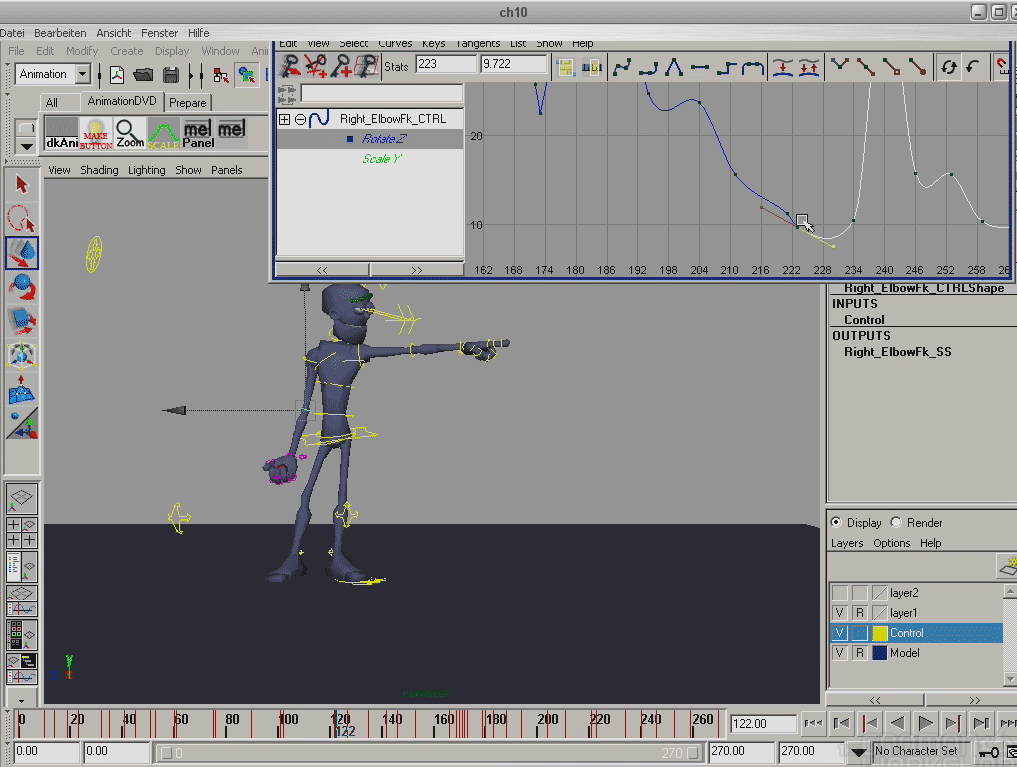
|
There's lots of things we can learn by looking over Robert's shoulders. Even advanced animators will enjoy his collegue's fresh and simple approach. The result is convincing. Robert Kuzcera has a talent of detecting minitature movements in the real character and applying it to the 3D character. Still amazing how long it takes. Most changes in this video tutorial are very subtle, anyway. One example: When lifting an arm our hands don't follow directly, the slightly rotate backwards befor they follow the motion of the elbow. Then they overshoot and rotate slightly back again. All these movements are hard to detect in the live video. But one you detect them it's straight forward to apply them to the 3D character. It results in a wave like flow of the arm. Robert stresses the fact that no motions start and stop at the same time and that things move in arcs. He applys the subtle motion even to the fingers - and in the end it pays off. Superimposing of motions is Robert's credo. It carries us through the whole DVD. |
Vieles lernt man in diesem Video. Selbst erfahrene Animatoren wird es freuen, einem Kollegen, der einen so radikal einfachen Ansatz wählt, über die Schultern zu sehen. Das Ergebnis beeindruckt. Robert Kuczera hat ein Talent, Feinheiten in den Bewegungen der Figur des Realfilms zu sehen und auf seinen 3D Character zu übertragen, dass sich beide am Ende zu gleichen scheinen. Erstaunlich, wie hoch der Aufwand dafür ist. Um z.B. das Heben eines Arms zu animieren, durchläuft der Arm mehrere Phasen. Insbesondere sorgt Robert dafür, dass keine Bewegung zur gleichen Zeit startet und endet. Wenn der Arm sich hebt, kann die Bewegung die Schulter, der Ellbogen oder die Hand einleiten. Wenn der Ellbogen sie einleitet, schwingt die Hand zunächst gegen die Bewegung des Arms nach unten, bevor sie der Ellbogendrehung folgt und nach oben überschießt. Das bewirkt eine leichte Wellenbewegung der Hand, die extrem natürlich aussieht. Im vorletzten Durchgang nimmt sich Robert Kuczera sogar der Finger an, die entsprechend noch träger der Bewegung des Arms folgen. Die Überlappung von Sub-Animationen ist das Credo dieser DVD. |
|
The problem I have with this tutorial DVD is tiny compared to the gains I got. The problem is that in 2 hours many things feel lengthy and tedious. Maybe Gnomon insists on the real time feeling, not skipping a single step. Robert tries to explain several general issues of character animation while doing his rotation/translation/keyframing marathon. But for long periods I did not quite understand what he's doing. Many changes he applies are so miniature that I can't follow. When he says "Now it's a little bit too strong" and cuts, pastes, moves keyframes a dozen times and then comments: "Looks much better now" - In many cases I can't appreciate the change because I can't see it. It probably would help to stop at certain points and compare detailed movements before/after. But this maybe isn't intendend in the Gnomon workshop series. I've encountered similar problems with the wonderful Painter-DVDs by Ryan Church (Lucas Film). There's too much detail that you often miss the real point. |
Das Problem des Tutorials ist im Vergleich zum Gewinn minimal: Über die Länge von 2 Stunden wird Vieles zu langatmig und bleibt zu unklar. Die Vorgabe ist offenbar, keinen Schritt auszulassen, alles zu zeigen. Das zieht sich in die Länge. Zwar versucht Robert Kuczera während seiner vielen Tausenden von kleinen Veränderungen der Figur stets zu beschreiben, was er tut, aber man versteht über weite Strecken nicht, was er tut. Viele Veränderungen sind so minimal, dass man nicht nachvollziehen kann, wenn Robert sagt "Now it's a little bit too strong" und dann einige Dutzend Male Keyframes ausschneidet, einsetzt, verschiebt und dann zufrieden kommentiert: "Looks much better now". Hier würde es helfen, wenn man sich bestimmte Detailbewegungen in Ruhe näher ansehen könnte und Robert das Vorher/Nachher gegeneinander stellen würde. Offenbar widerspricht das dem Konzept der Workshop-Reihe. Ich kenne Ähnliches von den außerordentlich gelungenen Painter-DVDs von Ryan Church (Lucas Film). Es wimmelt so von Detailarbeit, dass man den großen Bogen oft aus den Augen verliert. |
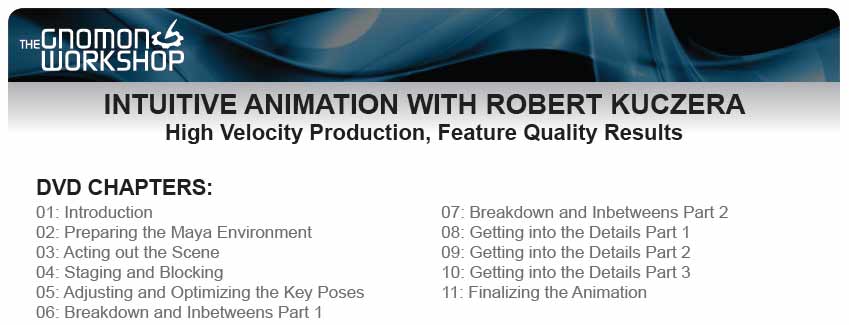
|
Basically this first tutorial by Robert Kuzcera is a remarkable piece of work. It shows how to animate a character in 3D with very simple and direct means, without big tools like Motion Builder, inverse kinematics or non linear animation. Apart from that Robert is nice to listen to - a handsome person. At several stages he expresses his wish to have a better feeling for timing. Musicians, he suggests, are better at timing. Towards the end he mentions that he doesn't care about new releases of Maya. His technique, he says, always stays the same. He advices the viewer to go ahead and download a free rig at www.highend3d.com or somewhere else and just start rotating it into a key pose... |
Unterm Strich ist dieses Erstlingswerk von Robert Kuczera ein beeindruckendes Stück Arbeit. Es zeigt, mit welch einfachen und direkten Mitteln, ohne große Werkzeuge wie Motion Builder, Inverse Kinematik und nonlineare Animation man zu exzellenten Ergebnissen kommt, eine 3D-Figur zu animieren. Außerdem ist der Protagonist sympathisch herüber, mit seiner oft fast flüsternden Stimme. An mehreren Stellen sagt Robert Kuczera, dass er sich wünscht, selber ein besseres Gefühl für Timing zu haben; er mutmaßt, dass Musiker hier privilegiert sind. Und mit seiner Bemerkung gegen Ende, dass ihm neue Versionen von Maya egal sind, denn seine Technik bliebe immer dieselbe, schwimmt er angenehmst gegen den Strom des immer Neuen, immer Besseren. Ja, er animiert den Zuschauer dazu, sich bei www.highend3d.com oder wo auch immer ein kostenloses Rig zu holen und erstmal in Grundstellungen zu drehen... |